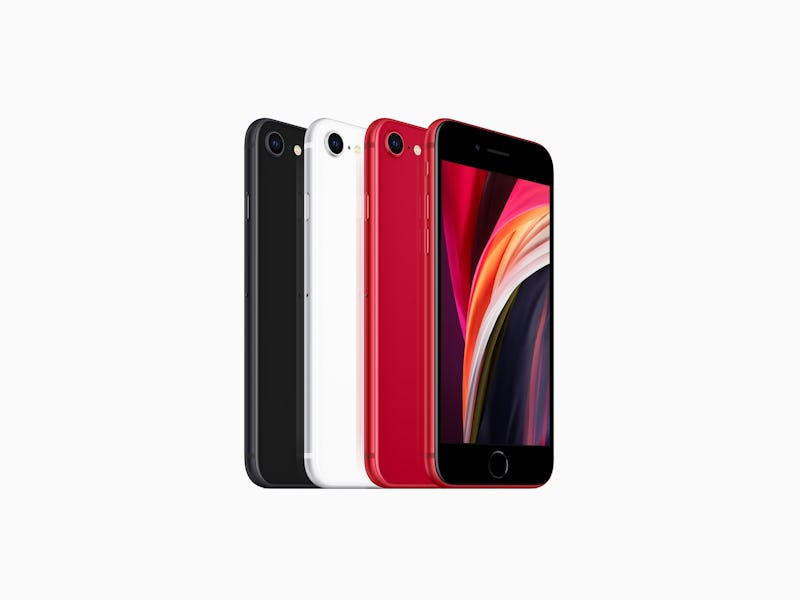Small is back
The new iPhone SE is here and it's basically an iPhone 8 that costs $399
RIP iPhone 8. Apple's new small and cheap iPhone SE is packing some old tech like a 4.7-inch LCD display and Touch ID, but the A13 Bionic processor is as powerful as the iPhone 11 Pro.

Continuing its blitz of spring hardware refreshes, Apple has brought the iPhone SE back from the dead. Well, sort of.
Discontinued in 2018, the new iPhone SE sports a larger display and updated specs. The original iPhone SE, released in March 2016, recycled the iPhone 5 and its 4-inch display and unibody aluminum design. But the new version cribs the iPhone 8 glass-and-metal sandwich aesthetic and 4.7-inch LCD screen.
Smaller and cheaper — The new iPhone SE isn't quite the same small smartphone the original was, but in the age of the 6.5-inch iPhone 11 Pro (rumored to grow to 6.7-inch on the "iPhone 12"), 6.78-inch OnePlus 8 Pro, and 6.9-inch Samsung Galaxy S20 Ultra, a 4.7-inch display is tiny. It's good to see Apple still cares about people with small hands who don't what to tote around a monstrous slab.
If none of this bothers you, like the original, the new iPhone SE also starts at $399. It'll be available for pre-order on Friday, April 17 and ship on April 24.
Three colors — The iPhone SE comes in white, black, and Product (RED).
Upgraded specs — Obviously. The new iPhone SE comes with an A13 Bionic chip (the same as the one in the iPhone 11 and 11 Pro) and three different storage capacities (64GB, 128GB, and 256GB). The 64GB is $399, the 128GB is $449, and the $256GB is $549.
There's a 12-megapixel camera on the back and 7-megapixel selfie camera on the front. Nothing special. if you want an ultra-wide or telephoto lens, you're going to need to look into a pricier iPhone, like the iPhone XR, 11, or 11 Pro.
Like the iPhone 8, the new iPhone SE is IP67 water-resistant also supports Qi-based wireless charging. Notably missing is a U1 Ultra Wideband chip, which is in the iPhone 11 and 11 Pro and is rumored to be the underlying technology for Apple's upcoming Tile-like "AirTag" item trackers.
All things considered, the iPhone SE is an iPhone 11 crammed into an iPhone 8 body (now discontinued) with a smaller LCD screen and Touch ID.
All things considered, the new iPhone SE is an iPhone 11 crammed into an iPhone 8 body.
Portrait mode using machine learning — The most interesting thing is that the front-facing camera can take portrait mode photos. The iPhone 8 couldn't take portrait shots — only the iPhone 8 Plus with its dual rear cameras.
According to Apple, the iPhone SE:
...uses the image signal processor and Neural Engine of A13 Bionic to unlock even more benefits of computational photography, including Portrait mode, all six Portrait Lighting effects and Depth Control. Using machine learning and monocular depth estimation, iPhone SE also takes stunning Portraits with the front camera.
"Monocular depth estimation" is a new technology for an iPhone. iPhones equipped with a TrueDepth camera system (iPhone X, XR, 11, and 11 Pro) create a depth map to blur out the background in selfies. It'll be interesting to see how the iPhone SE's portrait selfies compare.
Weirdly, the iPhone SE doesn't have a Night mode at all. This gives cheaper Android phones like the $399 Pixel 3a, which does have a Night Sight shooting mode, a slight advantage.
Express Transit — Also new: tap and go at transit terminals instead of pulling out a transit card. This wasn't supported on the iPhone 8.
Free Apple TV+ — Like all Apple device users, buying an iPhone SE also scores you a free year of Apple TV+. Good for watching exclusive shows like The Morning Show, For All Mankind, Little America and more.
More to come — Last month we got new iPad Pros, a Magic Keyboard with a trackpad, more affordable and powerful MacBook Airs, an updated Mac Mini, and new Apple Watch bands and iPhone 11 cases.
With no in-person WWDC event scheduled to take place this year due to COVID-19, Apple will be leaning more on online announcements for new products. The company is rumored to be announcing 14-inch MacBook Pros, over-ear headphones, and Tile-like "AirTag" item trackers at its June developer conference.
Meanwhile, Apple is still on track to announce new flagship iPhones — the iPhone 12 and 12 Pro — this fall. The smartphones are expected to come with faster chips, larger and smaller displays, 5G, and more advanced cameras (at least some models might have the new iPad Pro's LiDAR scanner).